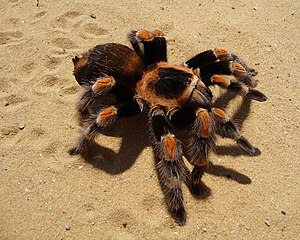Brachypelma smithi
| Brachypelma smithi | ||||||||||||
|---|---|---|---|---|---|---|---|---|---|---|---|---|

Brachypelma smithi , adult female |
||||||||||||
| Systematics | ||||||||||||
|
||||||||||||
| Scientific name | ||||||||||||
| Brachypelma smithi | ||||||||||||
| ( FOP-Cambridge , 1897) |
Brachypelma smithi ( Syn .: Brachypelma annitha ), also known in German as the Mexican red-knee tarantula or just the red-knee tarantula , is a Mexican species of tarantula from the genus Brachypelma . It was first described by Frederick Octavius Pickard-Cambridge in 1897. It is often kept as a terrarium animal.
distribution
This tarantula is found in Mexico . There you can find them in rain-green dry forests and dry savannas . She builds her caves on slopes or under stones. Its distribution area is in the south-west of Mexico, at the foot of the Sierra Madre del Sur ( Guerrero state ). There is also a second population, in the northern state of Colima .
Brachypelma smithi has been widely caught for sale and export in its natural range. For this reason, it was included in Appendix II of the Washington Convention on Endangered Species (WA) in 1985 , making it the first species of tarantula to fall under this Convention. The inclusion in the Washington Convention on Endangered Species regulates exports from their country of origin, Mexico. Owners of these animals need a certificate of origin. Today all Brachypelma species are protected.
Appearance
Brachypelma smithi can grow to be four to eight centimeters with a weight of about 15 grams . The front body is colored black and has a beige border. The bite claws and legs are also black. The fourth leg link, seen from the body, the knee, gave the species its German name because it is orange-red. The fifth and sixth leg links (splint and metatarsus) seen from the body have an orange-red ring at the bottom. The back of the body is black and, like the legs, has longer orange and reddish hair. She has stinging hairs on her abdomen .
It resembles the specimens of the "species" Brachypelma annitha, which is now regarded as a synonym . In contrast to this, the knees and leg rings in specimens of Brachypelma smithi are completely orange. In the case of specimens of Brachypelma annitha, however, the orange colored rings do not go completely around the entire leg.
behavior

If the spider feels attacked or irritated, it brushes off the stinging hairs on its abdomen with its rear legs and hurls them towards the attacker. If the spider is still harassed, it first goes into the impressive position with spread bite claws. If harassed further, she bites. The stinging hairs cause severe itching on the skin and inflammation of the mucous membranes. Stripped stinging hairs are replaced with each moult. Spiders that have already shed stinging hairs can be recognized by a bald spot on the abdomen. If this place becomes very dark due to the newly formed skin, the spider is about to molt.
The spider feeds on all animals that it can overwhelm. These are mostly small invertebrates. Their natural food also includes small lizards and small mammals (mainly rodents).
Reproduction
After moulting, the male has about one to two years to live. The male first builds a sperm net so that he can fill his bulbs. Then it's time to look for a bride. During the mating process, the male empties his bulbs into the female's spermathec. Some males are eaten by the female after mating. After successfully mating, the female builds a cocoon in the tube after about four to twelve weeks. Depending on the age and nutritional status of the female, there are between 300 and 1000 eggs in the cocoon. The term of employment is eight to eleven weeks.
Depending on the food available, it takes about five to ten years for the young to become sexually mature. In doing so, they go through about ten molts. The front body, legs, buttons and bite claws of the young animals are colored light brown. The abdomen is dark brown to black. From about the third moult, the young animals slowly change color with each moult to become adults. The young spiders also already have stinging hair on their abdomen.
Scientific description
It was first described in 1897 by FOP-Cambridge under the name Eurypelma smithi using two females from Dos Arroyos in Guerrero . He named the animal after HH Smith . The spider was given its current name in 1903 by Reginald Innes Pocock .
literature
- Frederick O. Pickard-Cambridge: Arachnida. Araneidea and Opiliones. Volume II, pub. for the editors by RH Porter, London 1897-1905. (Full text)
- Peter Klaas: Tarantulas: Origin, Care, Species. Eugen Ulmer Verlag, Stuttgart 2003, ISBN 3-8001-3696-1 .
- Boris Striffler, A. Graminske: Brachypelma - the colorful tarantulas of Mexico. In: DRACO. 4 (16), 2003, pp. 52-61.
- Boris Striffler: The Red Knee Tarantula. Natur und Tier-Verlag, Münster 2004, ISBN 3-937285-10-5 .
- RC West: The Brachypelma species from Mexico. In: ARACHNE. 11 (1), 2006, pp. 4-17
Individual evidence
- ↑ A. Locht, M. Yáñez, I. Vãzquez: Distribution and natural history of mexican species of Brachypelma and Brachypelmides (Theraphosidae, Theraphosinae) with morphological evidence for their synonymy , in: The Journal of Arachnology 27. 1999. P. 196– 200.
Web links
Brachypelma smithi in the World Spider Catalog
- brachypelma-smithi.de All information and forum about the red knee tarantula B. smithi
- brachypelma smithi Lots of additions and additional information on the (red knee tarantula) Brachypelma smithi
- Brachypelma smithi inthe IUCN Red List of Threatened Species 2013.2. Listed by: World Conservation Monitoring Center, 1996. Retrieved January 18, 2014.
